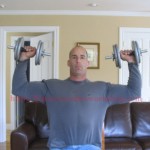Preventing Injuries During Bodybuilding
Preventing Injuries: OK, this is important so I’m going to repeat it – use Good Form. You cant use proper form if you are lifting too much weight – don’t be an ego-lifter! Use slow, controlled motions and avoid jerking or bouncing. Just remember this, if you get injured lifting too much weight it can set you back months or years in your bodybuilding progress. Ask anyone with a torn rotator cuff how much their life sucks and you will understand what I mean.
Just using good form isn’t enough to prevent injuries, you need to know what joint positions make you vulnerable to injury. There is a whole group of people whole fervently believe that the larger the range of motion, the better – I call these people fullROMers. There are two types of fullROMers: those that have been injured and those who will be injured soon. :)
The most critical joint to avoid full ROM (Range Of Motion) is the shoulder. The shoulder is very unstable and vulnerable to injury when you allow the elbow to go behind the plane of your torso. For example, doing anything where the bar goes behind your neck puts your shoulders in this dangerous position. The modern weight room is an example how lawyers can benefit society. Because of lawsuits, most machines in the gym are equipped with safety stops which, if properly positioned, will safely limit ROM and prevent injury should you get in trouble – USE THEM! If you are doing free weights where safety stops are not available then use spotter(s). Here are other hints to keep from getting injured:
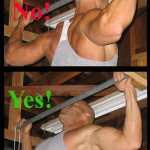
lat pull-downs: Do these in front of your neck, not behind your neck. The shoulder is very weak when the arms go behind the plane of your body and you risk shoulder injury if you do a behind-the-neck pull-up. Besides, it really doesn’t work your lats any better.
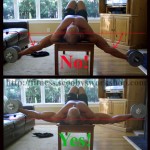
Chest pec dec and flys: Again, don’t let your arms go behind the plane of your body. I know it feels good to get that extra stretch but the shoulder is weak in that position. (click on image for larger view)
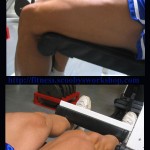
Leg extensions: Only do the last 15 degrees from leg completely straight, slightly bent, then back to completely straight – otherwise this exercise is really bad for the knees.
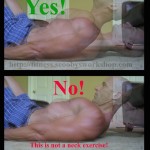 Abs: The crunch is done incorrectly more often than any other exercise. It is very common to see someone whipping their head up which does nothing at all for the abs and risks neck injury to boot. Don’t nod your head – keep your shoulders, neck and head immobile – you are focusing on raising your shoulders slowly to the ceiling while staring at a fixed point above you. Don’t do a traditional ‘sit-up’ either, bending at the pelvis is hard on your back and doesn’t work the abs much anyway. (click on image for larger view)
Abs: The crunch is done incorrectly more often than any other exercise. It is very common to see someone whipping their head up which does nothing at all for the abs and risks neck injury to boot. Don’t nod your head – keep your shoulders, neck and head immobile – you are focusing on raising your shoulders slowly to the ceiling while staring at a fixed point above you. Don’t do a traditional ‘sit-up’ either, bending at the pelvis is hard on your back and doesn’t work the abs much anyway. (click on image for larger view)
Squats and leg press: Stop when the knee angle is 90 degrees, don’t be bouncin’ your butt off your heels unless you want to have surgery on your knees. (click on thumbnail for a larger view)
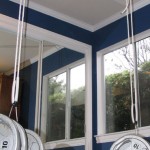
Either have a competent spotter or stick to machines and when you use machines make sure to use the safety stops. If you are working out at home alone, then build a self-spotting rig like the one I designed here. The weights in this picture are in position for me to do chest dumbbell press while laying on the floor.
Be careful picking up 45lb plates, learn to lift properly using your legs. Don’t use 100lb plates, even if you are strong its not worth injuring yourself loading a machine
‘Safety’ collars: The modern olympic bar is an engineering marvel. It is designed so that if a bodybuilder gives out and drops one hand, the weights on the low side slide off which makes that side pop up allowing the other side to dump – a built in simple safety feature. If you put on ‘safety’ collars, you are defeating the safety mechanism. First of all, if this happens shame on everyone involved! If you were benching heavy without a spotter, what on earth were you thinking? If you had a spotter, what the heck were they doing? Granted, if you dump the weights in this fashion you have to hold onto the bar for dear life to keep it from catapulting and severely injuring someone nearby. If carefully used dumping in this fashion can keep your neck from being crushed by a bar. Don’t bench without a spotter! Safety collars are fine to use for biceps/triceps exercises where the weights are not in danger of crushing your neck.

